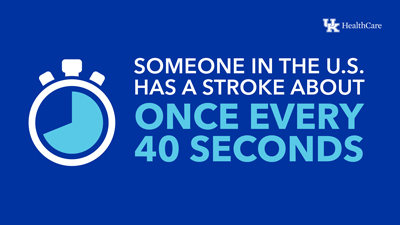What you need to know about stroke
What is stroke?
A stroke, or brain attack, happens when a blood vessel carrying oxygen and nutrients to the brain is blocked by a clot (ischemic stroke) or bursts (hemorrhagic stroke). When an artery is blocked, the brain can’t get the blood and oxygen it needs. Brain cells can die from the lack of blood and oxygen.
Ischemic strokes are the most common type. There are three types of blood vessel blockages in the brain or neck that cause ischemic strokes:
- Thrombosis: The formation of a clot within a blood vessel of the brain or neck.
- Embolism: The movement of a clot from another part of the body, such as the heart, to the neck or brain.
- Stenosis: A severe narrowing of an artery in or leading to the brain.
 If a blood vessel bursts inside your brain, a hemorrhagic stroke can take place. Approximately 20 percent of all strokes are hemorrhagic strokes. Damage occurs either because of the blood that leaks into the brain or because the fluid increases pressure on the brain. This hurts your brain by pressing it against the skull or the brain stem.
If a blood vessel bursts inside your brain, a hemorrhagic stroke can take place. Approximately 20 percent of all strokes are hemorrhagic strokes. Damage occurs either because of the blood that leaks into the brain or because the fluid increases pressure on the brain. This hurts your brain by pressing it against the skull or the brain stem.
A stroke may also occur because a brain aneurysm, or a weak area in the wall of an artery that supplies blood to the brain, ruptures.
Stroke: who's at risk?
Stroke deprives the brain of blood, killing brain cells and often leading to disability or death. This serious condition is all too common nationally and in Kentucky. Studies show who and how many are having strokes, and they also indicate the reasons why. You can act now to reduce your chances of suffering a stroke and avoid becoming part of these statistics.
Stroke is the fifth-leading cause of death in the United States, killing about 140,300 people annually. That’s one of every 20 deaths in the nation. How common is stroke?
- About 800,000 strokes occur each year in the U.S.
- About 3 in 4 are first-time strokes.
- Someone has a stroke about every 40 seconds.
- Someone dies of a stroke about every four minutes.
U.S. stroke death rates
U.S. Stroke Death Rates 2013-2015 for adults 35+ by county showing prevalence of stroke in Kentucky; up to 207 deaths per 100,000 in many counties. Data Source: National Vital Statistics System; National Center for Health Statistics.
Stroke in Kentucky
Kentucky tied for 12th among the states in the number of stroke deaths in 2015 with 2,050. Stroke was the fifth-leading killer in the state behind cancer, heart disease, chronic lower respiratory disease, and accidents.
A report prepared in 2017 for the state government analyzed stroke statistics for Kentucky for 2015. Here’s some of what it found:
- 60 percent of those who had strokes in Kentucky were older than 65.
- 34 percent were 46 to 65.
- 12 percent were older than 85, and 6 percent were 18 to 45.
- 51 percent were women.
- 88 percent were white; 10 percent black; 1 percent Latino.
Risk factors in Kentucky
High blood pressure, high cholesterol, diabetes, cigarette smoking, obesity, and irregular heartbeat are all top risk factors for stroke. That means anyone with one or more of those conditions is more likely to have a stroke.
Of those who had strokes in Kentucky in 2015:
- 75 percent had high blood pressure.
- 36 percent had high cholesterol.
- 34 percent had diabetes.
- 23 percent were cigarette smokers.
- 17 percent were obese.
- 16 percent had atrial fibrillation or heart flutter.
Reducing your chances of having a stroke
Your lifestyle choices can help determine whether you will suffer from a stroke. Here are some steps you can take immediately or in the near future:
- Get a checkup. Ask your doctor whether your state of health makes you a likely stroke victim.
- Get a stroke screening. University of Kentucky HealthCare screens hundreds of people for stroke each year. Email Britan.Schenk@uky.edu or call 859-323-3092.
- The UK Stroke Program screens hundreds of individuals each year. If you are planning a community event and would like to offer a stroke risk screening, please complete the request form.
- Change your lifestyle to minimize risk factors. Lose weight (if you are overweight), quit smoking, start exercising, and modify your diet to reduce cholesterol. Your healthcare professional can help you develop a plan for all of this.
Learn more about prevention
In Stroke, Timing is Everything »
Resources
National Stroke Association – 1-800-787-6537
American Stroke Association – 1-888-478-7653

